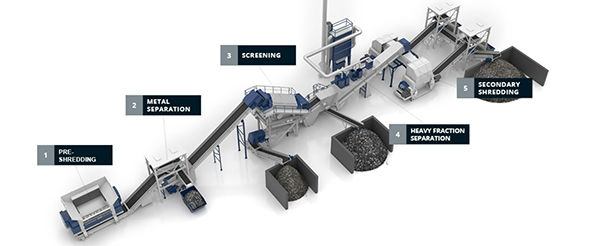MULTI-STEP PROCESSING OF PREMIUM SOLID RECOVERED FUELS

PRIMARY SHREDDING
The process starts with untreated waste from households, commerce and industries being fed – often via wheel loaders, diggers or dosing conveyors – into the primary shredder. The aim is to obtain homogeneous, sortable material ready for the next step in the process.
MAGNETIC SEPARATION
In the second step, an overbelt magnet is used to securely extract ferromagnetic parts such as scrap iron and other ferrous scrap metal. Ferrous scrap metal in premium solid recovered fuels is said to spoil its quality. Once separated, it can be recycled.
SCREENING
The screening technology selected is matched to your exact requirements and includes drum screens, strainers, vibrating screens or disc screens. Depending on your needs, it is possible to extract different fractions in this process stage, such as fine particles of
HEAVY FRACTION SEPARATION
Heavy fractions might cause increased wear or downtime in the secondary shredding process, which is why such fractions are sorted out. The material stream is fed continuously into a wind sifter where it is hit with an air current while it is in free fall. In this way, light materials are transported by air to the conveyor belt, whereas heavy materials fall to the ground to be discharged. Thanks to the circulating air, hardly any fresh air supply is needed.
SECONDARY SHREDDING
In the final stage of the process, the material is shredded a second time in a process called fine shredding. The material that is now free from foreign objects, heavy fractions and ferrous metal is fed into one or more secondary shredders depending on the system’s throughput capacity. The output is then known as premium solid recovered fuel (SRF). Systems typically generate up to 40 metric tons of final premium SRF per hour.